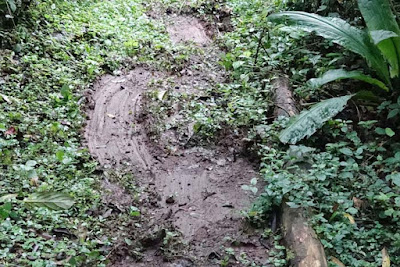 |
| Little Pansy (Junonia sophia), Kibale National Park, Uganda |
My friend Karen Minkowski, truly an intrepid tourist, has spent much of her life in the field observing wild animals. She spent several months last year in Africa, including time in Kibale Forest National Park. In this three part post she shares her photos and observations of some of the wildlife there, particularly its wonderful diversity of butterflies. Parts 2 and 3 will follow in the next two weeks.
 |
This
image of a Herminia Glider (Cymothoe herminia) looks more like a
chalk
pastel drawing than a photo.
|
Slogging through mucky swamps, slipping and
sliding on steep, wet slopes and occasionally beating a hasty retreat from
elephants, I was overjoyed to be in Uganda's beautiful Kibale Forest National
Park. As a volunteer with Makerere University Biological Field Station, on the
Park's western side, I was checking for missing ID tags on the trail system
that has been expanding since field studies began there in 1970. Wildlife was
all around me.
 |
| Black and white colobus monkey. |
In my free time I watched monkeys, looked for the birds that
were calling but hard to see, and photographed whatever I could. The butterflies
- diverse, elegant and often brilliantly colored - were among my favorite
subjects.
 |
A main “artery” road through the forest that provides access
to many trails
|
Forty-eight
years earlier I'd managed camp for a university field course in this forest. My
husband was one of the instructors (and Caroline's husband, Art, was a
student!). Since then I'd returned a few times for short visits only. Tropical
rain forest is for me a refuge, with its dense profusion of plant and animal
life. I wanted to get to know this forest at a slower pace, to have the time to
observe more deeply. And I hoped to see a particular purpley-blue butterfly
that I'd photographed in 1971 and carried a strong memory of all these years.
 |
| Black and white casqued hornbill. |
Kibale Forest
National Park's forests, grasslands, wetlands and woodlands support diverse and
abundant populations of plant and animal life. Here are just a few examples.
 |
| Bushbuck. |
 |
| Dung beetle. |
 |
| Blue-headed agama lizard. |
 |
| White-headed wood hoopoe. |
Trail work
ended at midday. My field assistant, Charles, had worked with the field station's
trail crew for over 20 years and knew the forest intimately. He had much
experience evading elephants and wanted us out of the forest well before early
evening, when elephants became more active.
From my point of view elephants were
active enough at any time of day, and more than once we abandoned work and left
the forest upon finding signs of their close but unseen presence. The sounds of
feeding, a pile of fresh warm dung, recently trampled vegetation – or the scent
of an elephant, which Charles, but not I, could detect – were evidence that
they were near. Though I
never saw elephants in Kibale, they were
always roaming through my head when I
was in the forest.
On weekends, Richard, a former field assistant from the local community, was my guide.
 |
| Richard is making a detour around elephant “potholes” (footprints) filled with water, as they can be quite mucky. |
 |
| With all
my slipping and sliding on wet trails, it was reassuring to see that elephants did the same. |
*****
I am very grateful to Dr. David Tumusiime
and Mr. Innocent Kato for welcoming me as a volunteer at the Makerere
University Biological Field Station and for their hospitality and support during my stay
from April 9 to June 19, 2019. Many others on the MUBFS staff and in the
Kanyawara community helped me as well. I thank Nelson Guma of Uganda Wildlife Authority
for expediting permission for me to reside and work in Kibale for that
time period.It was a remarkable experience that I
will always treasure. Thanks to Dr. Freerk Molleman, who kindly made available
for download his Butterflies of Uganda: Kibale Forest (2012) and also
identified some of my photos. Likewise, Dr. Sille Holm identified several moths
and the family of a moth larva. I also consulted The Anglia Ruskin
University guide to butterflies of Kibale Forest, Uganda, by Alvin J.
Helden, Fabrizio Manco and Sophie Mowles, v.2 (2018); A Field Guide to the
Butterflies of East Africa, by John G. Williams (1969); and the internet.
Any errors in identification are my own.










